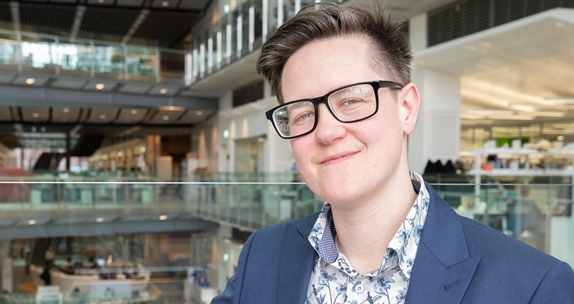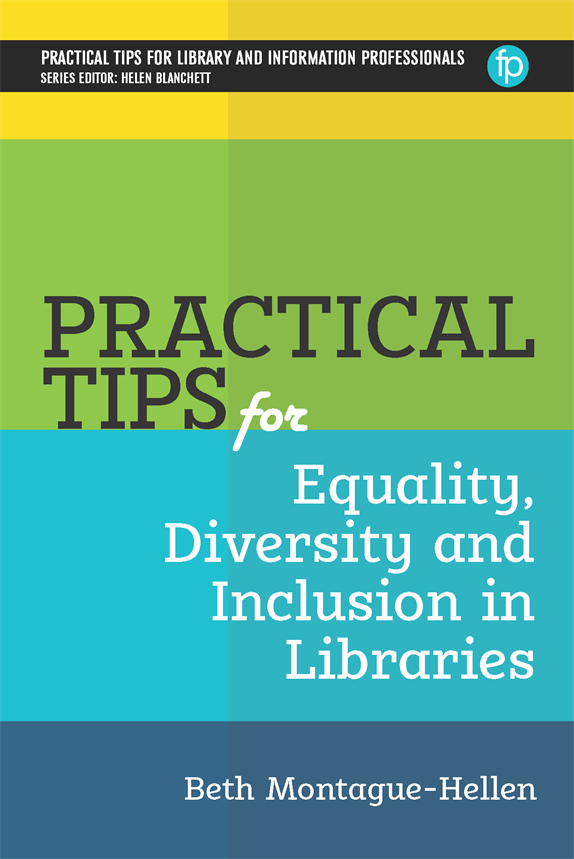
There are no perfect ways to improve EDI. Beth Montague-Hellen, author of Practical Tips for Equality, Diversity and Inclusion in Libraries discusses the fine lines and red lines.
EDI was high on the agenda for many organisations when Beth Montague-Hellen, Head of Library & Information Service, at The Francis Crick Institute, agreed to write the recently published Practical Tips for Equality, Diversity and Inclusion in Libraries.
“The tide was rising at that point,” Beth said, “powered by COVID and Black Lives Matter and it was like ‘yes, let’s do this’. But since then EDI has faded into the background, which in many ways makes this more important.”
Stamina
High profile pushbacks against EDI, particularly in the US, add weight to Beth’s final thoughts in the book. “Often social justice work is hard and lonely,” she wrote, adding that “If you burn out, you cannot help anyone.”
Speaking to Information Professional after the book was published, she said: “You’ve got to look after yourself. It’s very easy to burn out when you’re doing this kind of work and I’ve done that lots of times myself – I’ve felt like I
don’t care at all anymore.”
But there’s no long-term respite because “the problems are usually innate in people’s lives. People who aren’t personally involved can say ‘it’s too much I can’t do anymore’ but for the rest the issue is still there every day.”

The book
To counter the pressure, Beth’s book aims mainly for smaller, incremental wins. “I really wanted it to be practical,” she says, “I wasn’t going to write a deep theory-bound book. I wanted to say ‘here’s some practical stuff to help’.”
Beth also wanted to make sure it was easy to read despite covering a broad range of topics from the physical space to decolonisation.
“In libraries people come from all different backgrounds and subjects, not that everyone has that experience of social policy language. I’m a biologist by training and deep social theory is not my area at all. And so, I can’t assume that
other people have it either. If you have that knowledge you might think everybody else has it… and understands what phenomenology means.
“The theory is important for helping people look at what needs to be done and the bigger picture stuff. But everyone can look around and see if some people are getting opportunities and others aren’t without having to read lots of theory."
Direction not destination
The book aims to give step-by-step help for some of what could be a long journey. As an example Beth says that inclusion is a direction of travel, not a destination. “Including someone is saying ‘I am already at this table, look, you can come and sit’. It is not the same as belonging to a group of friends who you just sit with because you belong in that group. You don’t have to be invited to join.”
For an example she uses her own EDI activity with LGBTQ+ Stem, a project that helps LGBTQ+ researchers to find their place within science – in 2020 it won the Royal Society Athena Prize award for Beth and her co-organiser, Alex Bond.
She says: “When I did that project we had already built a community through social media so I belonged in that group. And LGBTQ+ Stem was us just saying, ‘we’re going to do our thing anyway, we can belong to our own group’. That is one
way of doing it, but it doesn’t fix the problem of integration into the mainstream, it just gave us a place at the time.
“We’ve got a Women in IT group in the IT department but it’s not really the belonging we want to get to. We want to get to the point where people feel they are so part of IT that their concerns and their issues are respected. They don’t have to be part of a separate group that understands them. You want that to actually just be the library. So it’s a stop gap on the way. But it’s about doing something now, to make people’s lives better versus the structural thing."
Red lines and grey areas
Another cause of EDI burnout is trying to fix the whole problem. “There can be an all-or-nothing approach to campaigning,” Beth says, “that if we don’t change it at the source, what’s the point of doing it all? And I don’t think that is the point – it’s certainly not the point with this book.
“What I’m trying to do is incrementally make things better. There’s a phrase that’s quite often used, particularly in neurodiversity and disability circles: ‘If something’s worth doing, it’s worth doing badly.’ So you don’t have to do
it perfectly. You don’t have to fix the whole problem. If you see all the catalogue desks are standing only and inaccessible to someone in a wheelchair, you look at how to fix it. “You haven’t fixed things at a policy level, but you
just literally made your library more useable and that’s what the book is trying to do.
“It’s not black and white, it’s all grey. It’s trying to work your way around things and compromise. That’s hard because people don’t like grey. They want there to be answers and in EDI there’s never a simple answer. It means sometimes
you have to leave it at the point where nobody’s perfectly happy, but it works better than it did before.”
Fear factor
Despite the book being designed to alleviate fear and enable action incrementally, fear of getting it wrong remains a significant factor. “I’m not worried about anti EDI people,” Beth says. “I know they’re there and they’re going to whatever
they do. I was worried about getting it wrong from our side. And that is one of the hardest things about writing about EDI – that we eat ourselves from the inside.
The thing that I was most worried about, writing this book, was that I would publish it and everyone on social media would just be like, ‘this is awful, what are you doing?’ and it would ruin my life. But the other book I see everywhere
at the moment is the one about kindness, The Kind Librarian, and I think even for people who are doing the campaigning it’s easy to forget that the other people are still people.”
Red lines and fine lines
EDI is full of grey areas but it comes with strong feelings that could make flexibility painful. Two areas that Beth mentions where lines tend to blur are making alliances and defining neutrality.
“It is important to make alliances with people you don’t 100 per cent agree with because otherwise you are only going to be stuck in your tiny little area. Working in LGBTQ+ I know lots of people I don’t agree with but I still have to
work with them. But it can go too far if it’s based on ‘they hate the same people as we do so let’s fight them together’ because afterwards they might hate you as well.”
In these cases she says a specific goal can be helpful, adding: “If you have a goal, bring everyone in who wants to work towards that goal, but don’t necessarily think that they’re going to help with anything else. They’re not your friends,
they’re your allies. And very disparate groups, who don’t agree in lots of other areas can work together but it does make it hard.”
Neutrality
“I don’t think it’s possible to be neutral,” Beth says, “It’s like saying ‘I’m happy with the way things are now, but I know they are not good for other people. I’m OK with that’.” But she adds: “There can be neutrality in situations like
the opposing groups who are using the library, where both groups are supported in accessing information. In that case it is always important to go back to what we’re doing as libraries – providing access to information. That’s what
we do – we don’t have to fix everything for everybody. That’s the closest, I think, to neutrality you can get.”
She also acknowledges that some organisations don’t have the resources to take a stand in all areas: “In the CILIP LGBTQ+ network (which Beth Chairs) we get a lot of queries about anti-trans texts in libraries and they often want guidelines
and policy. We don’t have either the right or the resources to do that, but we’re not neutral on it. We’re absolutely not neutral on it. If people are asking for a book and it’s a legal book you should provide it because you’re a library.
But you don’t have to promote that book.”
Library blindness
“Below qualified librarian level the library workforce becomes more diverse because the barriers to entry are easier. For a long time a Masters degree was a tick box. For a library assistant job though, you might be looking more for customer
service experience – something that a diverse range of people are likely to have. “There’s lots of studies saying that unless you think about it, you hire people who are similar to you. And people support those who are like them. The
result is that people see other people getting progressed and feel that they’re not allowed to be a librarian.
There are ways to get around this. One case study – from her days at the University of Nottingham, and which features in the book – was a spoken application for an EDI group trying to encourage people working at the front line. So porters,
people putting books on shelves, people who weren’t spending a lot of time writing. As opposed to the senior librarian who can bang out an application easily.
Bad listening
“Every time people decide they are taking EDI seriously they then say ‘I don’t really know the issues. I’m going to find the issues. I’ll send out a survey.’ But usually that’s where they’ve gone wrong because the chances are there was
a survey last year, and a survey three years ago. And nothing ever happened from those surveys.”
Instead, she says: “Look at the old surveys, at what people wanted. You might still need to ask whether it ‘is this still an issue?’, but if you do you also need to have already thought about a specific action that might help, and you
put that in the survey too. So you’re starting way down the line, not from the beginning again.”
Library listening
In the chapters on library estates – physical space – she says: “I spoke to people who had case studies like York, which was looking at students who have children – a specific space where there’s both working space for students and also
play space for the children. A lot of students with families were saying the library was not really for them because they couldn’t take their children in.”
Beth says the idea had not come from within the library, instead “it came from an open call, someone suggested it, and then librarians said it was a brilliant idea, let’s do it. So, it came about by listening.
"It’s about finding these ideas and putting them in front of people and they can ask “would that work in my library?” I don’t have experience of everybody’s libraries so I can’t give them detailed explanations. It can only ever be, here’s
the idea, what do you think?”




